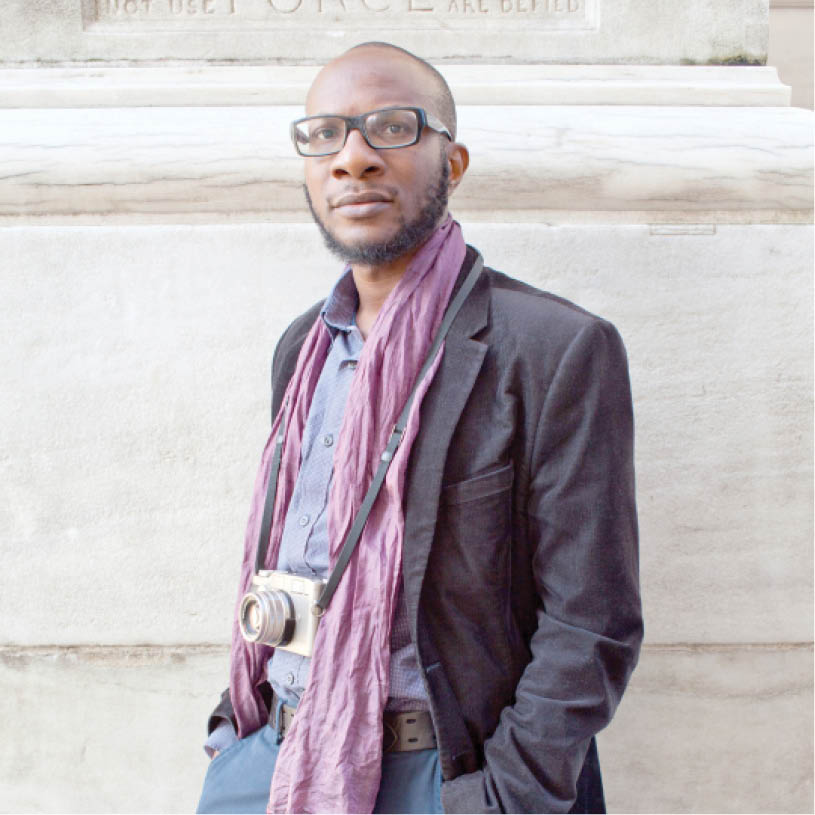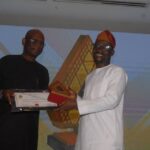Born in Michigan to Nigerian parents, Cole grew up in Lagos, but moved back to the United States to attend college. His writing is known for its probing examination of cultural identity, immigration, the environment, and race.
It is impossible to describe Teju Cole in a single word. He is an award-winning fiction writer and an essayist whose work regularly appears in The New Yorker, The Atlantic, Granta, and the New York Times. He is an art historian and photographer and his work has been exhibited internationally. He is a curator. He is a teacher—the Gore Vidal Professor of the Practice of Creative Writing at Harvard. In short, he is a contemporary Renaissance man.
Can you talk about how your work as a photographer and your love of the visual arts informs your writing and vice versa?
I feel very fortunate to be working in two distinct artistic fields: writing and visual arts. In the visual arts, my focus is on photography. But in writing, I range more widely. I’m not a poet or a dramatist, but I am an art critic, I write novels and short stories, and I do essays around a range of subjects. And I also work in forms that are less conventional—short forms, including, for example, the kinds of experiments I have done in my book Blind Spot.
However, about 15 years into my working life as an artist, I have found something interesting. Initially, I really thought what I was doing in writing and what I was doing in photography were just from two completely different universes. With each passing year, I feel they’re getting closer and closer together. What I mean by that is not that I surrender any of what makes writing writing, or what makes photography photography. After all, in any given field, we have to be responsible to the demands of craft and technique necessitated by that field. But for me, my practices of writing and photography are moving closer together because the intention, and the forms of focus and concentration, that I bring into each one now seem to me to spring from common roots.
A love of description characterizes my writing. I have a tendency to use a rather calm and formally settled approach. And I think this shows up in my photography as well. I don’t do a lot of action pictures: I’m often describing what is plainly there in the world, but trying to look at it with a strange eye. And I would say that photography has taught me also to be patient with my writing, because paradoxically, even though it’s just 1/125th of a second to take a photograph, finished photographs are very slow in gestation. It’s a lot of editing, a lot of selection, to find a photograph that’s worth keeping. I could travel to a place and make photographs there for three weeks and only come away with three or four photographs worth keeping. And that has taught me patience in my writing as well.
What attracted you to the visual arts and to writing in the first place?
Those two things have been with me for a very long time. I was an art major in college, but before that I was very committed to drawing and painting, and to art history, when I was in high school in Nigeria. And in fact, my three strongest subjects were English, art, and geography when I was in high school. I did well in science as well, but I topped the class in English, and I was near the top in art. So I think early on, I got the sense that these were things I had a talent for. And I continued that through college and grad school.
Around 2005, I started to take photos with real intentionality for the first time. It was around this time that I also found my language in writing. And when I say “I found my language,” I mean that I discovered the following: that what I wanted to do was write complex sentences about complex things, but to write them as simply and as carefully as possible. I wanted to write those sentences as lucidly as the complexity could bear. And once I discovered that commitment, it gave me the language to write my first published book, which was published in Nigeria: Every Day Is for the Thief, which I wrote at the beginning of 2006 and was published in 2007.
What subjects are you drawn to as a writer and a photographer?
Very many subjects! I think I fundamentally find the world an interesting place, and so I rarely rule out anything: politics, health policy, art history, memoir, of course the made-up things of fiction, but also scholarship, reportage of various kinds, literature, and music. That’s what interests me in writing, but I filter all of those things through my sensibility. Which is, I aim to get behind some unexpressed truth about whatever it is I’m looking at. So that all my work, regardless of the original material, ends up sounding like me. I think a lot of things in our culture and our society have a pose of innocence to them; as a writer, I’m driven to try to see what part of the story is not being told, what truths need to be extracted from that pose of innocence, but to do so in an artful and (usually) quite a subtle way.
As a photographer, meanwhile, I am constrained by the tool of photography: the camera. A camera is a seeing tool, and I can only photograph what’s in the world, what I see. My hope is to photograph in a way that illuminates “what’s in the world” in a new way. Usually, this means taking an unexpected angle on something. It means photographing things that have been disregarded.
So in writing, the unexpected. In photography, the disregarded. And the hope is that by making use of those unusual perspectives, I might genuinely have something new to say, even if I’m talking about something that many people have already talked about.
You are known for playing with new forms and structures. Can you talk about that?
Yes, I like to think about the difference between being experimental as a stance for its own sake and being free. Making use of the freedom is the artist’s prerogative. I really believe in trying to be both free and respectful of received forms. A given form is something that somebody else, another artist, arrives at in order to solve particular problems. When you’re working as an artist, you often find that somebody else’s form is not good enough for you, it’s not satisfying what you need for the project you’re working on. When I’m writing something, even if it starts out rather conventional, eventually I find that I’m changing things, breaking things, altering things, so that the work can better satisfy my inner vision of what I’m looking for. Which is why each one of my books has been in a different genre.
It’s finally a question of freedom: freedom, which is both a privilege and a responsibility. We’re responsible to make use of freedom in our work, both in terms of its form and its content.
Culled from http://www.bu.edu/
An independent, co-educational, and non-sectarian institution of higher education and research located along the banks of the Charles River in Boston, Massachusetts. It is the third largest independent university in the United States with 30,000 students. www.bu.edu

 Join Daily Trust WhatsApp Community For Quick Access To News and Happenings Around You.
Join Daily Trust WhatsApp Community For Quick Access To News and Happenings Around You.


